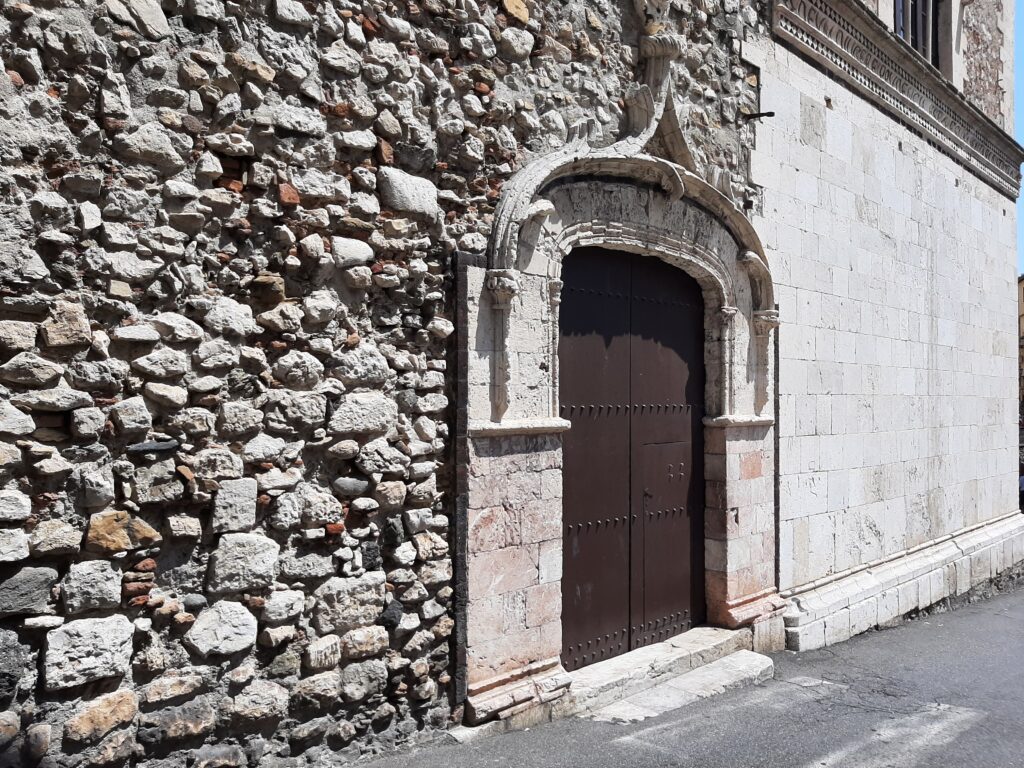In the heart of Taormina, between Piazza Badia and Corso Umberto, stands one of the city’s most emblematic buildings: Palazzo Corvaja. With its crenellated tower and stone mullioned windows, the palace tells centuries of history, power, and transformation. But who lived there? Who were its owners, and what role did they play in public life?
 The Origins of Palazzo Corvaja in Taormina: From Arab Tower to Norman Palace
The Origins of Palazzo Corvaja in Taormina: From Arab Tower to Norman Palace
The original core of Palazzo Corvaja in Taormina dates back to the Arab period (902–1079), when a defensive tower was built. With the arrival of the Normans, the structure was expanded and transformed into a noble residence. In the 13th century, under Frederick II of Swabia, the palace was entrusted to Don Juan de Termes, a Spanish nobleman who accompanied Queen Constance of Aragon to Sicily. Don Juan was appointed *Maestro Giustiziere*, a high-ranking judicial figure, and built the wing intended for the administration of justice.
The Sicilian Parliament and Queen Bianca
In 1411, Palazzo Corvaja in Taormina hosted a historic event: the meeting of the Sicilian Parliament, presided over by Bianca of Navarre, regent of the Kingdom of Sicily after the death of her husband, Martin the Younger. This episode gave the palace an important political role and the nickname “Palace of the Parliament.”
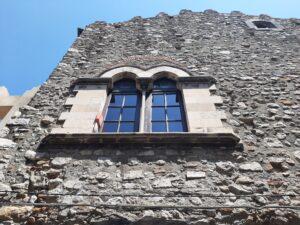 The Corvaja Family
The Corvaja Family
In 1538, Palazzo Corvaja in Taormina passed to the Corvaja family, one of the oldest and noblest in Taormina. The Corvaja family lived there for over four centuries, until 1945. During this long period, the family maintained a prestigious role in the city’s life, distinguishing itself for its social and cultural influence. The palace became the symbol of their lineage, and the very name of the building preserves their memory.
Abandonment and Renaissance
In the post-war period, the first mayor of Taormina decided to expropriate Palazzo Corvaja in Taormina, no longer inhabited by the Corvaja family. Between 1945 and 1948, the building underwent a major restoration by architect Armando Dillon, the same who restored Taormina’s Cathedral. Since then, Palazzo Corvaja has changed function: today it houses the Museum of Arts and Popular Traditions and the city’s tourist office.
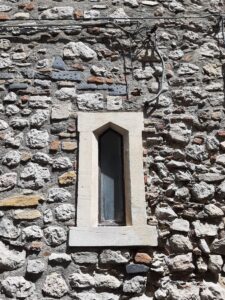 Palazzo Corvaja in Taormina is not just a monument: it is a silent witness to centuries of justice, power, and noble life. The family who lived there left an indelible mark on the history of Taormina, and the palace continues to tell it, stone by stone.
Palazzo Corvaja in Taormina is not just a monument: it is a silent witness to centuries of justice, power, and noble life. The family who lived there left an indelible mark on the history of Taormina, and the palace continues to tell it, stone by stone.
If you wish, I can add a section dedicated to the most significant architectural elements or to the legends linked to the Corvaja family. Let me know how you’d like to enrich it.
The Sicilian Parliament in Taormina: when Palazzo Corvaja became the political heart of the island
In 1411, Taormina was the stage of one of the most significant episodes in Sicilian institutional history: the meeting of the Sicilian Parliament at the majestic Palazzo Corvaja. In an era marked by dynastic tensions and power transitions, the city hosted the parliamentary assembly under the leadership of Regent Bianca of Navarre, widow of Martin the Younger and temporary sovereign of the Kingdom of Sicily.
The Sicilian Parliament, one of the oldest in Europe, was composed of three branches: feudal, ecclesiastical, and demanial. In Taormina, nobles, bishops, and representatives of the royal towns gathered to discuss the future of the crown, following the death of the sovereign. The choice of Palazzo Corvaja as the seat was no coincidence: its strategic location, solemn architecture, and established role as an administrative center made it the ideal place to host such an important assembly.
 The palace’s main hall, still visitable today, retains the austere and solemn atmosphere of that event. The stone walls, Gothic mullioned windows, and crenellated tower seem to guard the voices and debates of a time when Sicily sought to assert its political autonomy under Aragonese rule.
The palace’s main hall, still visitable today, retains the austere and solemn atmosphere of that event. The stone walls, Gothic mullioned windows, and crenellated tower seem to guard the voices and debates of a time when Sicily sought to assert its political autonomy under Aragonese rule.
That meeting of Parliament was not only a moment of dynastic transition, but also a symbol of the island’s political vitality. Taormina, for a brief but intense period, became the decision-making center of the kingdom, and Palazzo Corvaja its beating heart.
The Sicilian Parliament at Palazzo Corvaja: power, regency, and history in the heart of Taormina
Bianca of Navarre: the queen who ruled with courage
In 1411, the Sicilian Parliament met at Palazzo Corvaja under the regency of Bianca of Navarre, one of the strongest and most controversial female figures in the island’s medieval history. Widow of Martin the Younger, Bianca was appointed vicar of the Kingdom of Sicily by her father-in-law Martin the Elder, assuming full powers at a time of dynastic and political crisis.
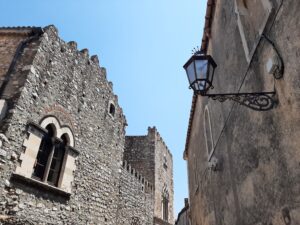 Bianca was not a mere regent: she boldly faced the ambitions of Count Bernardo Cabrera, who tried to overthrow her and even attempted to force her into marriage to seize the kingdom. Her leadership culminated in the convocation of Parliament in Taormina, where she sought to consolidate power and gain political legitimacy.
Bianca was not a mere regent: she boldly faced the ambitions of Count Bernardo Cabrera, who tried to overthrow her and even attempted to force her into marriage to seize the kingdom. Her leadership culminated in the convocation of Parliament in Taormina, where she sought to consolidate power and gain political legitimacy.
Palazzo Corvaja: from noble residence to seat of power
The palace, with its Norman-Aragonese architecture, was chosen as the parliamentary seat for its strategic location and symbolic prestige. Its halls hosted the three branches of Parliament:
Feudal: nobles and barons
Ecclesiastical: bishops, abbots, and archbishops
Demanial: representatives of the royal towns
This tripartite structure ensured a balance between aristocratic, religious, and urban power, making the Sicilian Parliament one of the most advanced in Europe for its time.
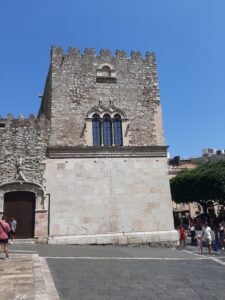 The European context of 1411: between wars and transitions
The European context of 1411: between wars and transitions
Elsewhere in Europe, 1411 was marked by tensions and changes:
In Italy, struggles between lordships and foreign powers were the order of the day. Sigismund of Luxembourg and Louis of Anjou descended into the peninsula with expansionist aims.
In Central Europe, the death of Jobst of Moravia opened new scenarios for imperial succession.
In Spain, the Crown of Aragon faced a dynastic crisis similar to that of Sicily, which would lead to the election of Ferdinand I of Aragon in 1412.
In this unstable scenario, Sicily sought to assert its autonomy, and the meeting of Parliament in Taormina was an act of resistance and identity affirmation.
How to Reach Palazzo Corvaja in Taormina: a practical guide for curious visitors
In the beating heart of Taormina, among cobbled streets and Mediterranean scents, stands the majestic Palazzo Corvaja, a symbol of medieval power and historic seat of the Sicilian Parliament. If you are planning a visit, here is everything you need to know to reach it easily.
Where it is located exactly
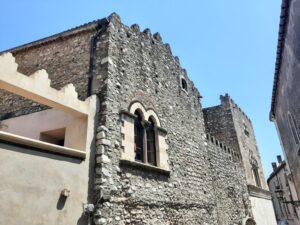 Palazzo Corvaja is located at the beginning of Corso Umberto, the main street of Taormina, less than 100 meters from Porta Messina. It overlooks Piazza Santa Caterina, right next to the Roman Theatre and just a few steps from the Palazzo dei Congressi. Its central location makes it easily accessible on foot from any point in the historic center.
Palazzo Corvaja is located at the beginning of Corso Umberto, the main street of Taormina, less than 100 meters from Porta Messina. It overlooks Piazza Santa Caterina, right next to the Roman Theatre and just a few steps from the Palazzo dei Congressi. Its central location makes it easily accessible on foot from any point in the historic center.
Getting to Taormina
By car
From Palermo or Messina, take the A18 motorway towards Catania and exit at Taormina.
From Catania, the A18 motorway takes you directly in about 45 minutes.
Once you arrive, you can park in multi-storey car parks such as Porta Catania or Lumbi, both connected to the center by free shuttles.
By train
The nearest train station is Taormina-Giardini, located about 4 km from the center.
From there, you can take a taxi or a local bus that drops you off near Porta Messina.
By bus
Interbus lines connect Taormina with the main Sicilian cities, including Catania, Messina, Palermo, and Fontanarossa Airport.
The main stop is just a few minutes’ walk from Palazzo Corvaja.
By plane
The nearest airport is Catania Fontanarossa. From there, you can take a direct bus to Taormina (about 1h 15min) or rent a car.
A walk in the historic center
Once in Taormina, I recommend exploring the center on foot. Palazzo Corvaja is surrounded by attractions such as the Ancient Theatre, the Public Gardens, and the

